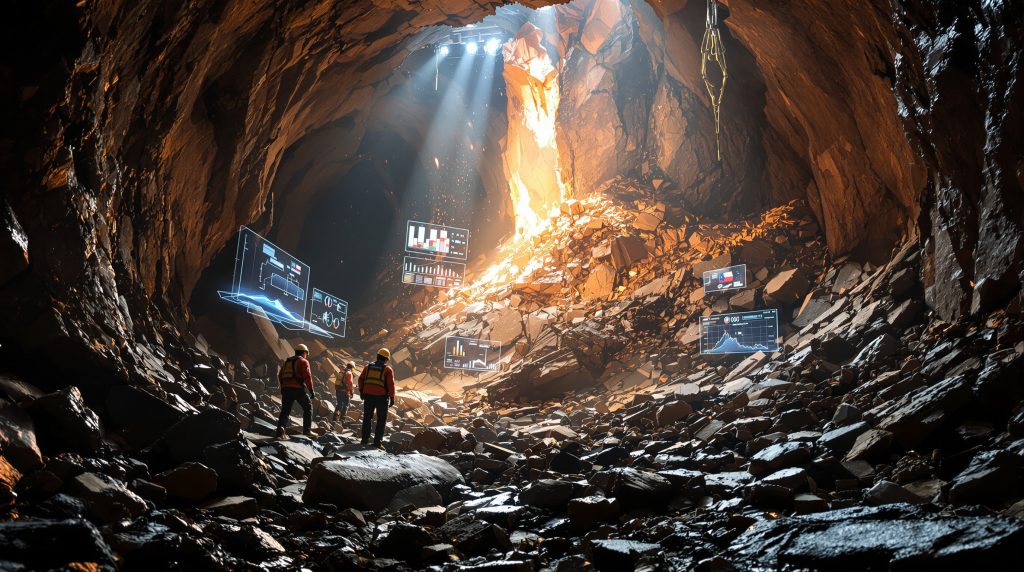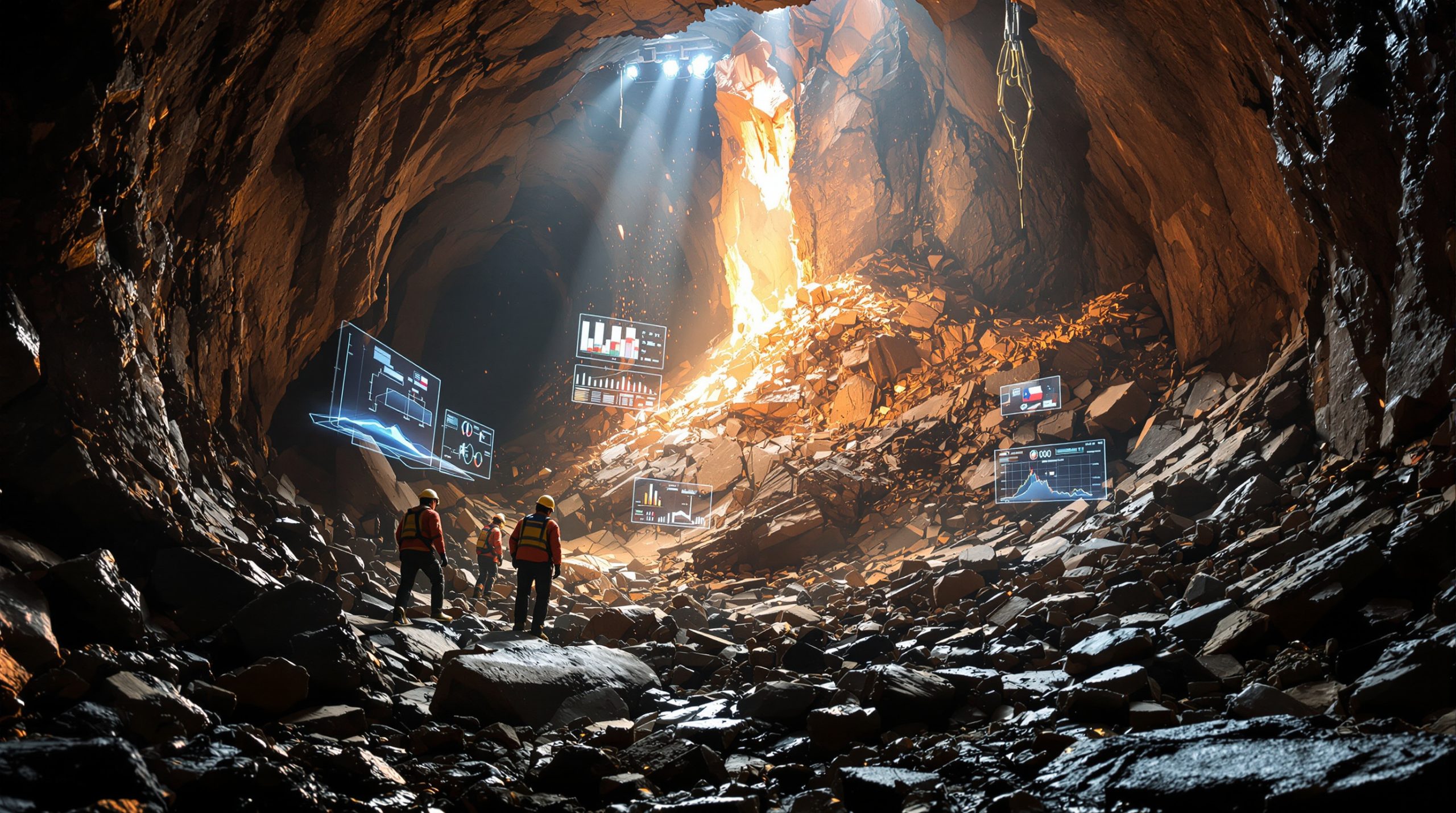What Happened at El Teniente Mine in Chile?
The El Teniente copper mine in Chile experienced a catastrophic collapse in July 2025, resulting in the deaths of six workers. This incident stands as the deadliest mining accident in Chile in recent years, sending shockwaves through the country's mining industry. The collapse occurred in Codelco's flagship copper operation, which is recognized as the world's largest underground copper mine.
Located in the Andes mountains about 80 kilometers southeast of Santiago, El Teniente has been in operation since 1905, making it one of the oldest continuously operating copper mines in the world. The mine employs approximately 4,000 workers directly and another 11,000 contractors, producing around 400,000 tonnes of copper annually.
The collapse occurred during a morning shift change at approximately 7:30 AM local time, when a section of tunnel in the mine's southern production area suddenly gave way. Initial reports suggested that seismic activity may have contributed to the structural failure, though this remains under investigation.
Initial Emergency Response
Following the collapse, rescue teams were immediately deployed to locate and rescue trapped miners. The emergency response involved more than 200 personnel, including specialized mine rescue teams from across Chile's mining sector. Despite extensive rescue efforts spanning over 72 hours, authorities eventually confirmed the deaths of all six workers who had been trapped by the collapse.
The Chilean government activated its National Emergency Office (ONEMI) protocol for mining disasters, coordinating efforts between Codelco's safety teams, regional emergency services, and military personnel. Advanced listening equipment and remote cameras were deployed to search for signs of life in the affected tunnel sections.
The tragedy prompted immediate safety reviews across Chile's mining operations and raised serious questions about safety protocols in the country's mining sector, particularly regarding tunnel support systems and seismic monitoring technologies.
Why Is the Investigation Taking Months to Complete?
According to Andres Leon, director of Chile's Sernageomin mining regulator, the investigation into the El Teniente mine accident impact will likely take months to finalize due to the complexity of the accident. In statements to international media, Leon emphasized that "due to the complexity of the accident it's hard to determine an exact date" for completion, but indicated that results should be available "in the next few months."
The intricate nature of underground mining accidents requires thorough examination of multiple factors, making it difficult to establish a precise completion date for the investigation. This timeline is consistent with previous major mining accident investigations in Chile, which typically require 3-6 months of detailed analysis.
Technical Challenges in Underground Investigations
Investigating underground mine collapses presents unique challenges compared to surface operations. Investigators must:
- Assess structural integrity of remaining tunnels before safely accessing the collapse site
- Analyze seismic data from before and during the incident to determine if earth movements contributed
- Examine rock mechanics and support systems to identify potential design or implementation failures
- Evaluate ventilation and emergency systems performance during the crisis
- Review maintenance records and previous safety inspections for early warning indicators
- Reconstruct the sequence of events through computer modeling and simulation
- Interview survivors, witnesses, and technical personnel who may have critical information
Adding further complexity is the need to preserve evidence while simultaneously ensuring the mine can eventually resume safe operations. Investigators must maintain the integrity of the accident scene while permitting essential maintenance and safety work.
Mining engineers familiar with similar investigations note that underground engineering marvels typically involve a chain of contributing factors rather than a single cause, necessitating a multidisciplinary approach involving geologists, engineers, safety specialists, and regulatory experts.
What Is Sernageomin's Role in Mine Safety Regulation?
Regulatory Authority and Responsibilities
Sernageomin (National Geology and Mining Service) serves as Chile's primary mining regulator with broad responsibility for oversight of the nation's mining industry. Established in 1980, this government agency operates under the Ministry of Mining and is tasked with enforcing safety standards across all mining operations in the country.
The agency's regulatory authority includes:
- Enforcing safety standards across all mining operations in Chile
- Conducting regular inspections of active mines (approximately 1,500 annual inspections)
- Investigating accidents and safety incidents through its specialized investigation unit
- Issuing regulations and safety guidelines based on international best practices
- Approving mining development plans and ensuring compliance with technical standards
- Maintaining the national mining cadastre and geological information system
- Certifying mine safety specialists and training programs
Led by Director Andres Leon since 2023, Sernageomin employs approximately 300 mining inspectors and technical specialists throughout Chile's mining regions.
Investigation Protocols for Fatal Accidents
When fatal accidents occur in Chilean mines, Sernageomin implements a structured investigation approach that follows international best practices while adapting to Chile's specific mining context. This process typically includes:
- Securing the accident site to preserve evidence through immediate suspension of activities
- Interviewing survivors, witnesses, and management to establish a chronology of events
- Reviewing operational procedures and safety protocols in place at the time of the accident
- Analyzing equipment and infrastructure conditions through detailed technical assessment
- Examining compliance with existing regulations and identifying potential regulatory gaps
- Coordinating with the Public Ministry when criminal negligence might be involved
- Developing recommendations for preventing similar incidents in the future
- Publishing findings to inform the broader mining industry
The agency is required by law to publish its findings and recommendations, though the timeline varies based on accident complexity. For major incidents like the El Teniente collapse, Sernageomin typically establishes a special committee of experts to ensure a comprehensive investigation.
How Does This Compare to Previous Mining Accidents in Chile?
Historical Context of Chilean Mining Disasters
The El Teniente tragedy joins a history of significant mining accidents in Chile, a country whose economy and identity are deeply intertwined with mining. While Chile's mining safety record has generally improved over recent decades, several notable incidents have occurred:
| Year | Mine | Incident | Casualties | Investigation Duration |
|---|---|---|---|---|
| 2010 | San José | Mine collapse and successful rescue | 0 (33 rescued) | 6 months |
| 2014 | Chuquicamata | Truck accident | 2 fatalities | 3 months |
| 2019 | Chuquicamata | Structural failure | 1 fatality | 4 months |
| 2023 | Atacama Region | Ventilation system failure | 3 fatalities | 5 months |
| 2025 | El Teniente | Tunnel collapse | 6 fatalities | Ongoing |
The most internationally recognized mining incident was the 2010 San José mine collapse, which trapped 33 miners for 69 days before their miraculous rescue. While that incident resulted in no fatalities, it prompted significant reforms in Chile's mining regulation frameworks and emergency protocols.
The El Teniente collapse represents the deadliest single mining incident in Chile since 2007, when an explosion at a coal mine in the Bío Bío region claimed eight lives. Industry analysts note that despite Chile's generally improving safety record, the risks inherent to underground mining remain significant, particularly as operations extend to greater depths.
Lessons from Past Investigations
Previous mining accident investigations in Chile have typically resulted in:
- Improved safety regulations and enforcement mechanisms
- Enhanced emergency response protocols and rescue capabilities
- Technological upgrades for early warning systems, particularly seismic monitoring
- Stricter maintenance requirements for critical infrastructure
- Better training programs for miners regarding hazard recognition
- Increased accountability for mine operators and management
- Industry-wide sharing of safety information and best practices
The San José mine incident, despite its ultimately successful outcome, led to the creation of a specialized mine rescue team and new regulations requiring improved emergency refuge chambers and communication systems in underground mines.
Mining safety experts suggest that the chile mine collapse investigation will likely focus on geotechnical factors, including rock burst prevention technology and tunnel reinforcement standards, areas that have gained increasing attention as mines reach greater depths with corresponding increases in geotechnical stress.
What Is Codelco's Safety Record and Response?
Company Profile and Safety History
Codelco (Corporación Nacional del Cobre de Chile), Chile's state-owned copper mining company, is one of the world's largest copper producers and a cornerstone of the Chilean economy:
- Operates El Teniente, the world's largest underground copper mine
- Produces approximately 10% of global copper output (1.68 million tonnes in 2024)
- Employs over 50,000 workers across multiple mining operations
- Contributes approximately 10% of Chile's national budget through transfers to the state
- Has faced increasing scrutiny over safety practices in recent years
The company has experienced a mixed safety record over the past decade. While its overall accident frequency rate has declined by approximately 40% since 2015, several high-profile incidents have raised concerns about safety management in its aging mines. Prior to the July 2025 accident, Codelco had recorded three fatal accidents across its operations in 2024, prompting calls from labor unions for improved safety investments.
Industry analysts note that Codelco faces particular challenges with its older operations, including El Teniente, where infrastructure dating back decades must be continuously modernized to meet contemporary safety standards. The company has invested approximately $2 billion in safety improvements since 2020, but critics argue that financial pressures may have led to delays in implementing certain safety enhancements.
Corporate Response to the Tragedy
Following the fatal accident, Codelco has:
- Temporarily suspended operations at affected sections of El Teniente
- Launched an internal investigation parallel to the regulatory probe
- Pledged full cooperation with government investigators
- Committed to reviewing and enhancing safety protocols
- Provided support to the families of deceased workers
- Established an independent safety review committee
- Accelerated planned safety infrastructure investments
In public statements, Codelco's CEO emphasized that "no production target justifies risking worker safety" and promised that the company would implement all recommendations from both internal and regulatory investigations. The company has also announced plans to accelerate the deployment of advanced seismic monitoring technology and remote mining systems.
Labor representatives, while acknowledging the company's response, have called for greater worker participation in safety management and more transparent reporting of safety concerns. The Chilean Mining Federation has requested that the findings of both internal and regulatory investigations be made public in their entirety.
What Safety Improvements Could Result from This Investigation?
Potential Regulatory Changes
The investigation may lead to significant changes in Chilean mining regulations, including:
- Stricter standards for underground support systems, particularly in seismically active zones
- Enhanced requirements for real-time monitoring technology, including distributed fiber optic sensing
- More frequent mandatory inspections of high-risk mining areas
- Updated emergency response protocols, including improved communication systems
- Revised training requirements for underground miners
- More stringent geotechnical assessment requirements before tunnel expansion
- Strengthened whistleblower protections for workers reporting safety concerns
- Increased penalties for safety violations resulting in serious injuries or fatalities
Mining safety experts anticipate that the El Teniente investigation could prompt Sernageomin to revise Chile's underground mining regulations, which were last substantially updated in 2021. Particular attention may focus on ground control standards and early warning systems for potential collapses.
Former Sernageomin officials have suggested that the investigation may lead to new requirements for third-party verification of mine design and support systems, similar to approaches used in Australia and Canada.
Technological Solutions for Prevention
Modern safety technologies that might be mandated following the investigation:
- Advanced seismic monitoring systems using machine learning to detect precursor events
- Remote-controlled mining equipment to reduce human exposure in high-risk areas
- Improved communication infrastructure in underground environments
- AI in mining safety powered predictive maintenance for critical infrastructure
- Enhanced personal protective equipment for miners
- Automated ground support systems that can be deployed without human presence
- Digital twin technology to model and simulate ground behavior before excavation
- Wireless sensor networks to detect early signs of structural stress
Industry leaders suggest that while many of these technologies are already available, their implementation has been uneven across Chile's mining sector due to cost considerations and operational disruptions during installation.
The investigation may also recommend accelerated adoption of technologies already proven in other mining jurisdictions, such as Australia's Mine Safety Management System approach, which integrates real-time monitoring with sophisticated risk assessment models.
How Does Chile's Mining Safety Compare Globally?
International Safety Standards Comparison
Chile's mining safety record compared to other major mining countries presents a mixed picture, with substantial improvements in recent decades but still lagging behind some leading mining nations:
| Country | Fatal Accidents per 100,000 Workers (2024) | Key Safety Regulations |
|---|---|---|
| Australia | 1.8 | Risk-based safety management systems |
| Canada | 2.3 | Provincial regulations with federal oversight |
| Chile | 3.7 | Centralized regulation through Sernageomin |
| Peru | 5.2 | Ministry of Energy and Mines oversight |
| South Africa | 6.1 | Mine Health and Safety Act with inspectorate |
| China | 9.8 | Improving but still higher fatality rates |
Chile has made significant progress in reducing mining fatalities, with accident rates declining by approximately 60% over the past two decades. However, the country still faces challenges in fully implementing and enforcing its safety regulations, particularly in smaller mining operations.
International mining safety experts note that Chile's centralized regulatory approach through Sernageomin provides consistent standards across the country, but may lack the flexibility and regional specificity found in federal systems like those in Canada and Australia.
Best Practices from Leading Mining Nations
Safety approaches that Chile could potentially adopt from countries with stronger safety records:
- Australia's risk assessment-based approach to modern mine planning, which requires comprehensive hazard identification before operations begin
- Canada's collaborative safety committees with worker representation and decision-making authority
- Norway's stringent third-party verification requirements for critical safety systems
- Sweden's technology-driven safety monitoring systems with real-time data integration
- Germany's comprehensive training certification programs for specialized mining roles
- Switzerland's transparent safety reporting and accountability frameworks
Mining industry consultants suggest that while Chile has strong technical regulations, it could benefit from greater emphasis on safety culture and worker empowerment. Studies have shown that mines with active worker participation in safety management typically experience fewer serious incidents.
Several international mining companies operating in Chile have already implemented global best practices that exceed local regulatory requirements, potentially providing models for broader adoption across the country's mining sector.
What Are the Economic Implications of the Accident?
Impact on Copper Production
The El Teniente accident has affected copper production in several ways:
- Temporary suspension of operations in affected areas, reducing output by approximately 20%
- Reduced output from Chile's flagship copper mine (normally 400,000 tonnes annually)
- Potential delays in planned expansion projects worth $3.4 billion
- Increased operational costs due to safety reviews and upgrades
- Ripple effects throughout the copper supply chain
- Implementation of more conservative mining approaches to prioritize safety
Industry analysts estimate that the production impact could amount to approximately 20,000-30,000 tonnes of copper output in 2025, representing about 0.15% of global annual production. While not catastrophic for global markets, the disruption comes at a time of tight copper supplies and growing demand from renewable energy and electric vehicle sectors.
For Codelco, the financial impact extends beyond lost production to include increased insurance costs, potential regulatory penalties, and necessary capital investments in safety improvements. The company has indicated that some planned production expansion projects may be delayed as resources are redirected toward safety enhancements.
Market Response and Copper Prices
Following the accident, copper markets responded with:
- Short-term price volatility due to supply uncertainty, with futures rising 2.8% in the week after the accident
- Increased focus on production forecasts from other major producers
- Heightened attention to safety risks in investment analyses
- Reassessment of global copper supply projections
- Greater scrutiny of operational risks in mining company valuations
- Growing premium for producers with strong safety records
Commodity market analysts note that while the immediate price impact was modest, the accident has contributed to growing investor awareness of operational risks in the mining sector. Several investment banks have revised their risk assessments for underground copper operations, potentially affecting capital allocation decisions.
The timing of the accident coincides with a period of growing copper demand driven by energy transition technologies, creating additional market sensitivity to any supply disruptions. Market forecasts suggest that sustained production reductions at El Teniente could contribute to a tighter global copper market through 2026.
What Are the Legal and Political Ramifications?
Potential Legal Consequences
The El Teniente accident may result in various legal proceedings:
- Criminal investigations if negligence is determined
- Civil liability claims from families of victims
- Regulatory penalties for safety violations
- Potential changes to mining laws and regulations
- Precedent-setting court decisions on mining safety responsibility
- Increased scrutiny of corporate compliance with existing regulations
- Class action lawsuits from shareholders alleging inadequate risk disclosure
Chile's legal framework for mining accidents includes both administrative penalties through Sernageomin and potential criminal prosecution through the Public Ministry. In previous fatal mining accidents, investigations have occasionally led to criminal charges against supervisors and executives when gross negligence was determined.
Legal experts note that Chile's courts have generally become more assertive in holding mining companies accountable for safety failures over the past decade. The El Teniente case could potentially establish new legal standards for corporate responsibility in mining safety, particularly regarding predictable geotechnical risks.
Political Dimensions of Mining Safety in Chile
The accident has political implications in Chile, where mining represents:
- Approximately 15% of the country's GDP
- A major source of export revenue and government income
- A significant employer in many regions
- A sector with strong labor unions and political influence
- A critical component of national economic development plans
- A frequent focal point for debates about environmental and social impacts
Chile's current administration has signaled that it will prioritize mining safety reforms following the accident, with the Minister of Mining announcing a comprehensive review of regulations governing underground operations. Opposition politicians have called for increased funding for Sernageomin and stronger enforcement capabilities.
Labor unions have used the incident to advocate for greater worker participation in safety decisions and stronger protections for those who report safety concerns. The Chilean Mining Federation has proposed legislation that would establish worker-led safety committees with the authority to stop operations when dangerous conditions are identified.
The political impact extends to Chile's international reputation as a responsible mining jurisdiction, potentially affecting foreign investment decisions. Government officials have emphasized their commitment to transparent investigation and meaningful reforms to maintain investor confidence.
FAQs About the Chile Mine Collapse Investigation
How long do mining accident investigations typically take in Chile?
Major mining accident investigations in Chile typically take between 3-6 months to complete, depending on the complexity of the incident. The El Teniente investigation is expected to be on the longer end of this spectrum due to the severity and underground nature of the collapse. Sernageomin director Andres Leon has indicated that while an exact timeline cannot be provided, results should be available "in the next few months."
Investigations involving underground collapses are particularly time-intensive because they require careful structural assessment before investigators can safely access all relevant areas. The process also involves extensive laboratory testing of rock samples, computer modeling of collapse dynamics, and detailed analysis of monitoring data from before and during the incident.
What compensation do families of mining accident victims receive in Chile?
Families of mining accident victims in Chile typically receive compensation through multiple channels, including workers' compensation insurance, company-provided benefits, and potentially additional settlements if negligence is proven. The specific amounts vary based on factors such as the worker's salary, years of service, and circumstances of the accident.
Chile's work accident insurance system provides immediate benefits covering funeral expenses and ongoing financial support to dependents. These statutory benefits are supplemented by company life insurance policies and often by additional compensation negotiated by labor unions.
In cases where company negligence is determined, families may pursue civil claims for additional damages. Historical settlements for fatal mining accidents in Chile have ranged from approximately $150,000 to over $500,000 per victim, depending on the degree of negligence established and the victim's family circumstances.
How will the investigation findings be implemented across other mines?
Once completed, the investigation findings will likely be translated into new safety directives issued by Sernageomin that apply to all similar mining operations in Chile. These may include immediate corrective actions, enhanced inspection requirements, and updated safety protocols that mines must implement within specified timeframes.
The implementation process typically follows several paths:
- Regulatory updates applied to all mines in the relevant category
- Technical bulletins detailing specific hazards and mitigation strategies
- Updated certification requirements for mining engineers and safety specialists
- Incorporation of findings into training curricula for mining professionals
- Targeted inspection campaigns focusing on issues identified in the investigation
Mining companies are generally given transition periods to implement major changes, with the timeline depending on the complexity and cost of the required modifications. Critical safety issues may trigger immediate action requirements, while systemic changes might be phased in over several months or years.
What role do mining unions play in safety investigations?
Mining unions in Chile typically participate in accident investigations by providing worker perspectives, reviewing safety protocols, and advocating for improved conditions. Union representatives often serve on safety committees and may conduct parallel investigations to ensure worker interests are represented in the official findings and recommendations.
The Chilean Mining Federation, which represents approximately 80% of Chile's unionized miners, has established technical teams that review safety incidents and provide input to regulatory investigations. These teams often include former miners with extensive underground experience who can offer practical insights into working conditions and operational realities.
Unions also play a crucial role in monitoring the implementation of safety recommendations after investigations conclude. Through collective bargaining agreements, many unions have secured rights to participate in safety inspections and review safety data, allowing them to verify that companies follow through on commitments made after accidents.
How might this accident affect international investment in Chilean mining?
While the accident raises short-term concerns about operational risks, Chile's long-established mining sector and rich mineral resources mean that international investment is likely to continue. However, investors may demand more rigorous safety assurances, potentially increasing costs for mining companies operating in the country.
Mining investment analysts suggest that the accident's impact will depend largely on the government's response. A transparent investigation followed by meaningful reforms could actually strengthen investor confidence in Chile's commitment to responsible mining practices. Conversely, any perception of regulatory inadequacy could raise risk premiums for Chilean mining projects.
Several international mining companies have indicated that they are closely monitoring the investigation's progress and findings. Investment decisions for new projects may incorporate additional safety margins and contingencies based on lessons learned from the El Teniente collapse.
Conclusion: The Path Forward for Mining Safety in Chile
The investigation into the El Teniente mine collapse represents a critical juncture for Chile's mining industry. As the world's largest copper producer, Chile faces the dual challenge of maintaining production while ensuring worker safety. The outcome of this investigation will likely influence safety practices not only within Codelco but across the global mining industry.
The months-long investigation process reflects the seriousness with which Chilean authorities are approaching this tragedy. By thoroughly examining the causes and contributing factors, regulators aim to prevent similar accidents in the future while maintaining Chile's position as a leading mining nation.
For the families of the six workers who lost their lives, no investigation can fully address their loss. However, the mining community's commitment to learning from this tragedy may help ensure that their deaths contribute to a safer future for Chile's miners.
Further Exploration:
Readers interested in learning more about mining safety investigations can also explore related educational content from MINING.com, which regularly covers developments in mine safety regulations and practices worldwide.
Want to Know When the Next Major Mining Discovery Happens?
Don't miss out on potentially transformative ASX mining discoveries when they're announced. Discovery Alert's proprietary Discovery IQ model delivers instant notifications when significant mineral discoveries occur, converting complex data into actionable investment opportunities. Visit the discoveries page to see how past discoveries have yielded exceptional returns for early investors.




